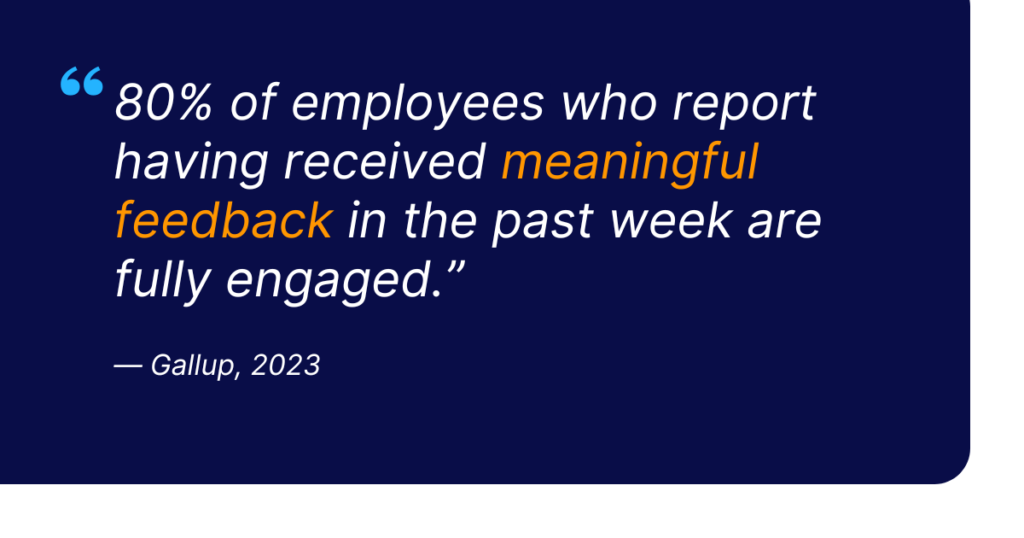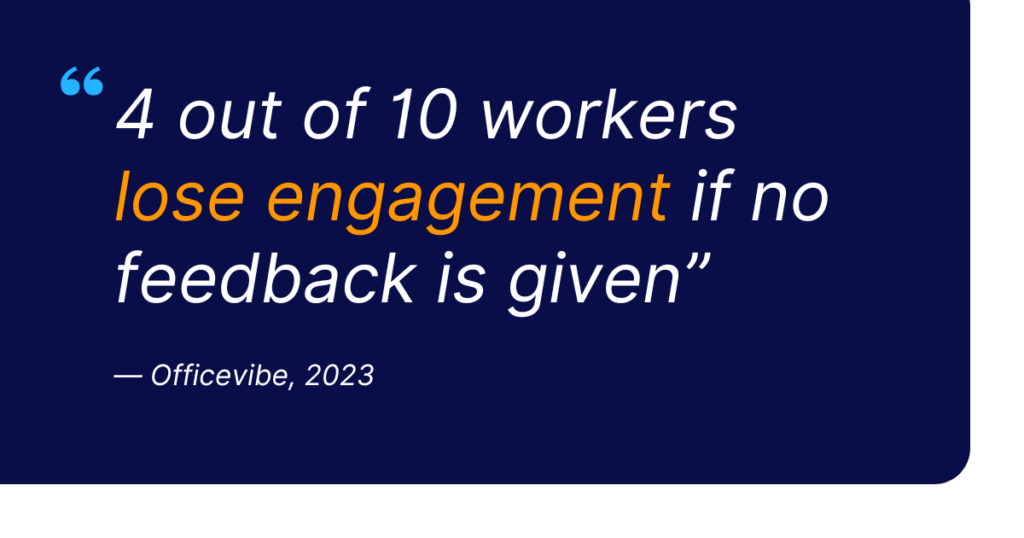Ask any C-level executive about the keys to business success, and employee engagement is likely to be near — if not at — the top of their list. But with engagement numbers seemingly stuck at around 30 percent, ways to improve those lackluster results remain seemingly elusive. But did you know that according to Gallup research, 80 percent of employees who report having received “meaningful feedback” in the past week are fully engaged. Could it be that employee feedback is the secret sauce for cooking up positive engagement? Let’s have a look.
What is employee feedback?
Employee feedback is all about providing constructive comments, praise, or evaluations to employees regarding their performance, behavior, or contributions in the workplace. It serves as a key tool for professional development, enhancing performance, and fostering a positive work environment. Feedback can be given through various channels, including formal evaluations, informal conversations, peer assessments, and managerial discussions. It aims to guide employees in achieving their goals, improving skills, and aligning with organizational objectives. Exactly what constitutes effective, meaningful feedback will vary from person to person, but essentially it involves a balance of positive reinforcement, constructive criticism, and clear communication to support employee growth and success.

Why is employee feedback important?
Employee feedback is crucial for lots of different reasons. First of all, it facilitates professional growth and development by providing employees with insights into their performance, strengths, and areas for improvement. Constructive feedback helps individuals understand how they can enhance their skills and capabilities, ultimately contributing to their career advancement.
Additionally, feedback is part and parcel of a culture of continuous improvement within organizations, promoting accountability and motivation among employees. It also strengthens communication and trust between managers and their teams, as transparent feedback demonstrates a commitment to employee success and well-being.
Moreover, feedback encourages engagement and productivity by recognizing employees’ contributions and reinforcing positive behaviors. By offering regular and meaningful feedback, organizations can ultimately cultivate a supportive and high-performing work environment conducive to both individual and collective success.

How to give and get employee feedback
What’s the best way to give negative feedback?
Delivering negative feedback to an employee is never fun, but it’s essential to approach the situation with empathy, clarity, and a focus on constructive solutions. Here are seven steps to consider:
- Choose the Right Time and Place: Select a private and appropriate setting where the employee is likely to feel comfortable and respected, ensuring confidentiality and minimizing distractions.
- Be Specific and Objective: Clearly articulate the issue or behavior that needs improvement, providing specific examples to illustrate your points. Focus on observable actions rather than subjective judgments.
- Offer Constructive Criticism: Frame your feedback in a way that highlights opportunities for growth and improvement. Instead of criticizing the person, address the behavior or performance issue and suggest actionable steps to address it.
- Use “I” Statements: Express your observations and concerns using “I” statements to avoid sounding accusatory or confrontational. For example, say, “I noticed that there have been delays in meeting project deadlines,” rather than, “You’re always missing deadlines.”
- Encourage Dialogue: Create an open and supportive environment where the employee feels comfortable discussing their perspective and asking questions. Listen actively to their feedback and concerns, demonstrating empathy and understanding.
- Focus on Solutions: Collaborate with the employee to develop a plan for improvement, setting clear expectations and goals. Offer guidance, resources, or training opportunities to help them address the issue effectively.
- Follow Up: Schedule a follow-up meeting to review progress and provide ongoing support and encouragement. And be sure to recognize and acknowledge any positive changes or efforts made by the employee.
What’s the best way to give positive feedback?
Knowing how to give positive employee feedback is key to building a culture of appreciation, motivation, and engagement. When delivered thoughtfully, it can reinforce desired behaviors and inspire continued success. Here are seven steps to guide you:
- Be Prompt: Share positive feedback as soon as possible after the action or achievement. Timely recognition makes praise feel more genuine and impactful, and it reinforces the behavior when it’s still fresh in the employee’s mind.
- Be Specific: Instead of a vague “Good job,” describe exactly what the employee did well and why it mattered. For example, “Your detailed report helped clarify the budget for the entire team,” provides more value than a generic compliment.
- Connect to Business Goals or Values: Show how the employee’s actions align with broader company objectives or cultural values. This helps reinforce the behavior as something that contributes to collective success, not just individual performance.
- Recognize the Impact: Highlight how the employee’s contribution made a difference — to a colleague, project, customer, or team outcome. This builds a deeper understanding of the value of their work.
- Tailor Your Approach: Everyone appreciates recognition differently. Some employees enjoy public praise, while others prefer private acknowledgment. Consider their preferences to make your feedback even more meaningful.
- Encourage Continued Excellence: Let the employee know that their efforts are seen and appreciated, and that you’re excited to see more of the same. This helps turn one-time wins into ongoing strengths.
- Make It a Habit: Don’t save praise for rare occasions. Make positive feedback part of your regular communication. A culture of appreciation doesn’t require grand gestures — just consistent, sincere recognition.
How do I collect employee feedback?
Soliciting feedback allows organizations to gain valuable insights into employee experiences, concerns, and suggestions, enabling them to identify areas ripe for improvement, enhance employee engagement, and foster a culture of continuous learning and growth.
- Regular Surveys: Conduct periodic surveys to gather anonymous feedback on various aspects of the workplace, including satisfaction levels, communication effectiveness, and suggestions for improvement.
- Open-Door Policy: Maintain policies where employees feel comfortable approaching managers and/or leaders with their feedback, concerns, or ideas. This is sure to foster a culture of transparency and trust.
- Anonymous Feedback Channels: Provide channels for employees to submit feedback anonymously, such as suggestion boxes, online forms, or dedicated email addresses, ensuring confidentiality and encouraging honest input.
- Performance Reviews: Incorporate opportunities for two-way feedback during performance reviews or one-on-one meetings, allowing employees to share their perspectives on their performance, career goals, and development needs.
- Employee Forums or Town Halls: Host regular forums or town hall meetings where employees can openly discuss issues, ask questions, and share feedback directly with senior leadership or management teams, promoting dialogue and collaboration.
- Team Meetings and Check-Ins: Integrate feedback sessions into team meetings or regular check-ins to discuss progress, address challenges, and gather input on team dynamics, processes, and goals, enhancing team communication and cohesion.
- Recognition Programs: Implement employee recognition programs that encourage peers and managers to provide positive feedback and acknowledgment for exceptional contributions, fostering a culture of appreciation and recognition within the organization.
How can managers improve employee satisfaction with the feedback process?
Managers can go a long way toward improving satisfaction with the feedback process by creating a safe environment for open communication and by ensuring feedback sessions are constructive and supportive. Approach feedback with empathy, focusing on solutions and development opportunities. By tailoring feedback to individual goals and providing concrete examples, managers can foster a more positive reception. Clear action items and a willingness to listen and adjust show employees that their well-being and professional growth are priorities.
25 employee feedback types, with examples:
There are many different types of employee feedback. Here’s our top 25.
1. Positive feedback
Recognizing and praising an employee’s achievements, contributions, or positive behaviors.
- Example 1: “Great job on completing the project ahead of schedule! Your dedication and hard work are truly commendable.”
- Example 2: “Thank you for always going above and beyond to assist your colleagues. Your helpfulness is invaluable to the team.”
2. Constructive feedback
Providing feedback aimed at improving performance or correcting behavior in a supportive manner.
- Example 1: “Your attention to detail is excellent, but I noticed a few areas in your presentation where you could improve clarity.”
- Example 2: “Your communication skills are strong, but I think you could benefit from being more assertive in team meetings to ensure your ideas are heard.”
3. Performance feedback
Assessing an employee’s performance based on predefined goals, targets, or job responsibilities.
- Example 1: “You consistently meet or exceed sales targets, demonstrating exceptional performance in driving revenue.”
- Example 2: “Your ability to meet project deadlines and deliver high-quality work has significantly contributed to the success of our team.”
4. Developmental feedback
Offering feedback intended to help an employee grow, develop new skills, or advance in their career.
- Example 1: “I see potential for you to further develop your leadership skills. Taking on a mentorship role for newer team members could help you grow in this area.”
- Example 2: “Improving your time management skills could help you handle multiple projects more effectively. Consider using time-tracking tools or adopting prioritization techniques.”
5. Behavioral feedback
Addressing specific behaviors exhibited by an employee, whether positive or negative.
- Example 1: “Your proactive approach to problem-solving has been instrumental in resolving issues before they escalate. Keep up the excellent work.”
- Example 2: “I’ve noticed that you tend to interrupt others during meetings. Being more mindful of giving everyone a chance to speak will help foster better collaboration.”
6. Continuous feedback
Providing ongoing feedback on an employee’s performance, rather than waiting for formal reviews.
- Example 1: “I wanted to provide some feedback on your recent project presentation. While your content was strong, I noticed that you spoke very quickly, making it challenging for the audience to follow. Maybe try to slow down your pace next time.”
- Example 2: “Thank you for your quick response to the customer’s inquiry yesterday. Your timely assistance demonstrates your commitment to providing excellent customer service.”
7. Formal feedback
Scheduled feedback sessions or performance evaluations conducted at regular intervals, such as quarterly or annually.
- Example 1: “During your quarterly performance review, we discussed areas where you excel, such as your strong analytical skills. We also identified opportunities for improvement, such as time management, which we’ll work on together in the coming months.”
- Example 2: “Your annual performance evaluation highlighted your consistent contributions to the team’s success, including your ability to adapt to changing priorities and deliver results under pressure.”
8. Informal feedback
Spontaneous, day-to-day feedback given in casual conversations or interactions.
- Example 1: “I wanted to let you know that your initiative in proposing new ideas during our team meetings is appreciated. Your creativity often sparks valuable discussions.”
- Example 2: “Thanks for your help with the project yesterday. Your attention to detail ensured that everything ran smoothly.”
9. 360-degree feedback
Gathering feedback from multiple sources, including peers, managers, subordinates, and sometimes external stakeholders.
- Example 1: “Your peers have highlighted your strong collaboration skills and ability to work well within a team.”
- Example 2: “Your direct reports appreciate your supportive leadership style and willingness to listen to their concerns.”
10. Specific feedback
Providing detailed feedback on a particular aspect of performance or behavior.
- Example 1: “Your presentation skills have improved significantly since our last training session. Your use of visuals and storytelling techniques made the content engaging and memorable.”
- Example 2: “Your attention to detail in reviewing documents ensures that errors are caught early in the process, preventing delays.”
11. General feedback
Offering broad feedback that covers overall performance or behavior without focusing on specific details.
- Example 1: “Overall, your performance has been consistently strong, and your positive attitude has a positive impact on the team dynamic.”
- Example 2: “You consistently demonstrate professionalism and reliability in your work, which contributes to the overall success of the team.”
12. Timely feedback
Giving feedback promptly after an event or situation occurs, rather than waiting.
- Example 1: “Thank you for stepping up and taking on additional responsibilities during our busiest period. Your flexibility and willingness to help out were greatly appreciated.”
- Example 2: “I noticed that you handled the customer complaint with professionalism and empathy. Your quick response helped resolve the issue and maintain customer satisfaction.”
13. Goal-oriented feedback
Aligning feedback with an employee’s goals, objectives, or developmental plans.
- Example 1: “Your progress towards achieving your quarterly sales targets has been impressive. Let’s discuss strategies to maintain this momentum and surpass our goals.”
- Example 2: “You have made significant progress in improving your time management skills, which aligns with your goal of becoming more efficient in your work.”
14. Skill-based feedback
Providing feedback on specific skills or competencies relevant to the employee’s role.
- Example 1: “Your technical skills in data analysis are exceptional, and your ability to interpret complex data sets sets you apart from your peers.”
- Example 2: “Your proficiency in coding has improved significantly since you started taking online courses. Your dedication to skill development is commendable.”
15. Recognition feedback
Acknowledging and appreciating an employee’s efforts, accomplishments, or contributions.
- Example 1: “Congratulations on receiving the Employee of the Month award! Your consistent dedication and positive attitude make you a valuable asset to the team.”
- Example 2: “I wanted to acknowledge the outstanding customer feedback we received about your exceptional service. Your commitment to exceeding customer expectations is commendable.”
16. Corrective feedback
Addressing performance or behavior issues that need improvement.
- Example 1: “I noticed that there were several errors in your report. Let’s review them together and discuss strategies to prevent similar mistakes in the future.”
- Example 2: “Your tardiness has been impacting team meetings. Let’s work together to find a solution to ensure you can arrive on time consistently.”
17. Appreciative feedback
Expressing gratitude or appreciation for an employee’s efforts, attitude, or support.
- Example 1: “Thank you for always being willing to lend a helping hand to your colleagues. Your willingness to support others does not go unnoticed.”
- Example 2: “Your positive attitude and enthusiasm for your work are contagious and contribute to a positive work environment for everyone.”
18. Peer feedback
Feedback provided by colleagues or teammates rather than by a supervisor or manager.
- Example 1: “I appreciate your collaborative approach to problem-solving. Your willingness to listen to different perspectives and work together as a team is commendable.”
- Example 2: “Your attention to detail in reviewing project documents ensures that errors are caught early, saving time and preventing rework for the team.”
19. Managerial feedback
Feedback given by a supervisor or manager regarding an employee’s performance, behavior, or development.
- Example 1: “Your leadership skills have had a positive impact on the team. Your ability to motivate and inspire others to achieve their goals is commendable.”
- Example 2: “Your proactive approach to addressing customer concerns demonstrates your commitment to providing excellent service. Your efforts are appreciated by both the team and our customers.”
20. Self-assessment feedback
Encouraging employees to evaluate their own performance and providing feedback based on their self-assessment.
- Example 1: “In your self-assessment, you identified communication skills as an area for improvement. Let’s discuss strategies to help you develop these skills further.”
- Example 2: “You mentioned in your self-assessment that you struggle with time management. Let’s work together to identify time-saving techniques and prioritize tasks effectively.”
21. Situational feedback
Tailoring feedback to specific situations, projects, or tasks.
- Example 1: “During the client presentation, your ability to answer questions confidently and articulate key points effectively was impressive.”
- Example 2: “In the recent team meeting, I noticed that you actively contributed to the discussion and provided valuable insights.”
22. Long-term feedback
Discussing trends or patterns observed over an extended period, such as progress over several months or years.
- Example 1: “Over the past year, your consistent dedication to your work and willingness to take on new challenges have been evident. Your contributions have been instrumental in the team’s success.”
- Example 2: “Since joining the company, your growth and development have been remarkable. Your commitment to learning and improvement has positioned you as a valuable asset to the team.”
23. Performance improvement feedback
Offering feedback aimed at helping an employee overcome performance challenges or barriers.
- Example 1: “Your recent sales numbers have been below expectations. Let’s work together to identify areas for improvement and develop a plan to help you achieve your targets.”
- Example 2: “I’ve noticed that you’ve been struggling with meeting project deadlines. Let’s discuss strategies to improve time management and prioritize tasks effectively.”
24. Objective feedback
Providing feedback based on measurable, observable facts rather than subjective opinions.
- Example 1: “Your ability to meet project deadlines consistently is evident from the project metrics, which show that you have completed all tasks on time.”
- Example 2: “Customer feedback surveys consistently rate your service as excellent, highlighting your professionalism and commitment to customer satisfaction.”
25. Cultural fit feedback
Assessing how well an employee’s values, attitudes, and behaviors align with the organization’s culture and values.
- Example 1: “Your ability to collaborate effectively with colleagues from different departments demonstrates your alignment with our company’s collaborative culture.”
- Example 2: “Your enthusiasm for volunteering for company events and initiatives reflects your commitment to our company values of community engagement and social responsibility.”
Each type of feedback serves a unique purpose in helping employees understand their performance, grow professionally, and contribute effectively to the organization.
These examples illustrate how various types of feedback can be effectively used to recognize achievements, address areas for improvement, and support employee development within an organization.
Following up on employee feedback effectively
Don’t forget: following up is one of the most crucial aspects of the feedback process, ensuring that employees feel heard and valued. After gathering feedback, managers should acknowledge receipt and outline any actions or changes being considered. A follow-up doesn’t have to be immediate, but regular updates keep employees informed and engaged. When managers take steps to address feedback, employees are more likely to share future insights, knowing their input directly shapes company culture.
How Staffbase helps you gather employee feedback
Effective employee feedback is a two-way street. While giving feedback is crucial, collecting it systematically ensures that employees feel heard and valued. Staffbase offers robust tools to facilitate this process seamlessly.
Quick Pulse Surveys
Staffbase’s Quick Pulse Surveys allow you to check in with employees through one-question surveys using a 5-star rating format. These are ideal for gauging employee sentiment on well-being, new policies, or recent changes. You can schedule these surveys regularly or deploy them as needed, providing real-time insights into your organization’s pulse.
Comprehensive Multi-Question Surveys
For deeper insights, Staffbase enables the creation of multi-question surveys with various question types. This flexibility allows you to explore specific topics in detail, such as team dynamics, workload distribution, or management practices. The results are presented in real-time, broken down by question, facilitating immediate analysis and action.
Email Pulse Surveys
Integrate feedback collection into your regular communications with Staffbase’s Email Pulse Surveys. By embedding surveys directly into emails, you can gather feedback on specific topics or initiatives, making it convenient for employees to share their thoughts.
Smart Impact Analytics
Understanding the effectiveness of your communications is vital. Staffbase’s Smart Impact Analytics provides metrics on views, audience reactions, and sentiment. Additionally, alignment surveys help gauge employee agreement with company content, offering a comprehensive view of engagement levels.
Employee Engagement Platform
Staffbase’s platform is designed to enhance employee engagement through features like social walls, automated journeys, and recognition tools. These features not only foster a sense of community but also encourage transparency and continuous feedback, contributing to a positive work culture.
Ready to Elevate Your Employee Feedback Strategy?
Discover how Staffbase can transform your approach to employee feedback. Book a demo today and take the first step towards a more engaged and responsive workplace.
Frequently Asked Questions about employee feedback
How can managers improve employee satisfaction with the feedback process?
Managers can improve satisfaction by making feedback a two-way, ongoing conversation — not a once-a-year event. Prioritize regular check-ins, use clear and constructive language, and actively listen to employee perspectives. A consistent, respectful approach helps employees feel supported rather than judged.
How to collect anonymous employee feedback?
Use anonymous surveys or suggestion boxes (digital or physical) to create a safe space for honest feedback. Platforms like Staffbase offer tools to gather anonymous input, ensuring employees can share concerns without fear of repercussions.
How to encourage employee feedback?
Create a culture where feedback is welcomed and acted upon. Show appreciation when employees speak up, and demonstrate that their input leads to real change. Transparency, follow-through, and regular opportunities for dialogue all build trust.
How to give a positive feedback for an employee?
Be specific, timely, and sincere. Focus on what the employee did well, why it mattered, and how it contributed to the team or company. Tailor your praise to the individual, and don’t wait for big wins—small wins deserve recognition too.
How to give critical feedback to an employee?
Approach it with empathy and clarity. Address the behavior — not the person — using specific examples. Frame your feedback as an opportunity for growth, and invite dialogue to ensure mutual understanding and alignment on next steps.
How to give employee feedback on their performance?
Focus on both strengths and areas for improvement. Use real examples tied to goals or expectations. Keep the tone constructive, provide actionable advice, and follow up regularly to support ongoing development.
How to give feedback to a sensitive employee?
Use a gentle, supportive tone and deliver feedback privately. Acknowledge their strengths, ease into constructive points with care, and allow time for them to process. Above all, lead with empathy and patience.



